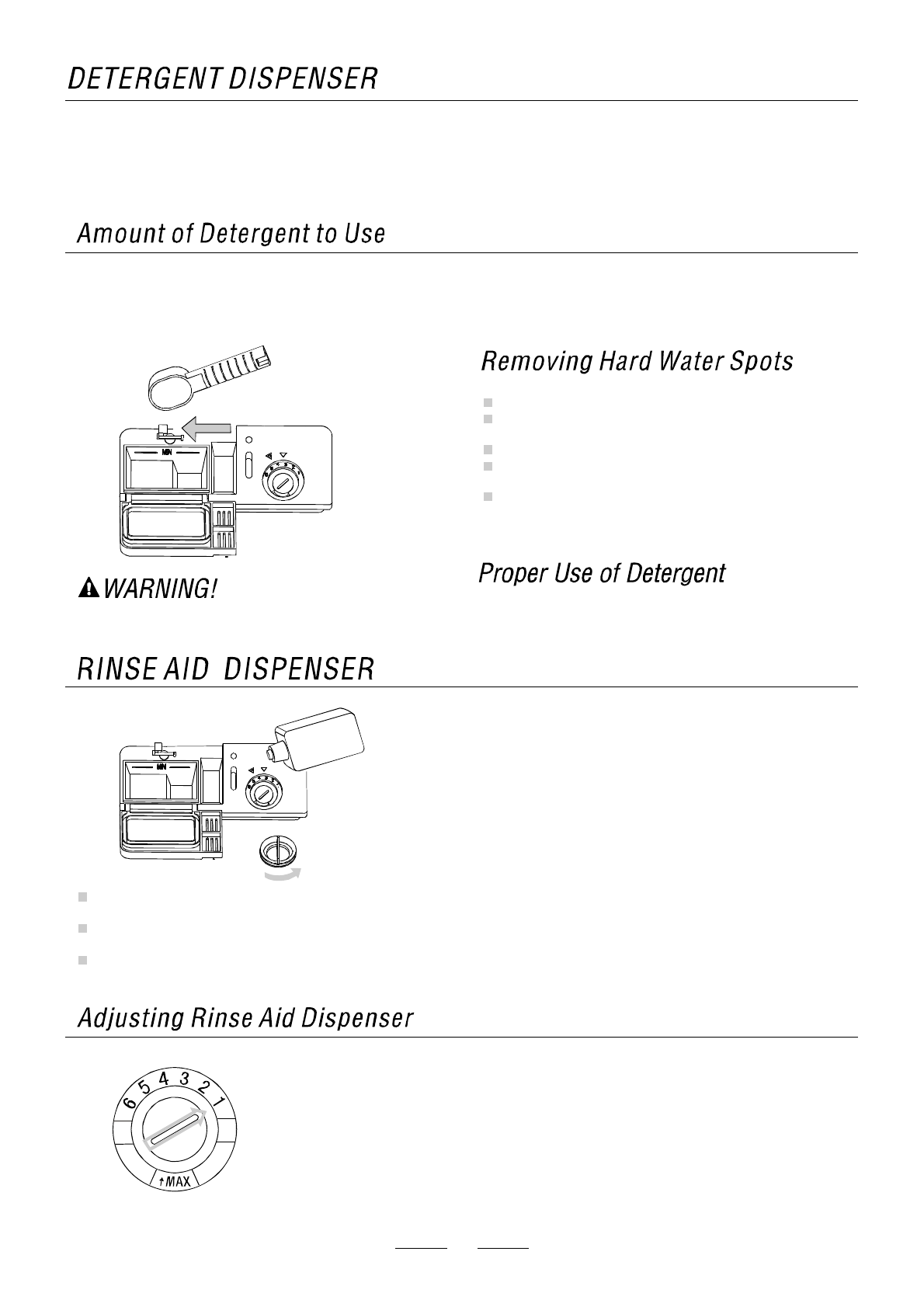
5
Dishwasher detergent iscorrosive! Take care to keepit out
of reach of children.
IF THE WATER ISN'T TOO HARD, YOU MAY ALSO PREVENT THE FORMATION OF DEPOSITSBY ADDING DETERGENT.
The amountof detergent needed can vary dueto differences in waterhardness. Todetermine thewater hardness in your area,
contact your local water utility or area water softening company. Theharder the water, the more detergent you may need.
Remember,you should adjust the amount ofdetergent youuse by small amounts until you find the correctamount.
To remove hard water spots, try the following:
Run dishes through a normal wash program.
Removeall metal dishware, such as cutlery, pans,etc.,
from the dishwasher.
Do not add detergent.
Pour two cups of vinegar into a bowland set the bowl face
up on the lower rack of thedishwasher.
Runthe dishes througha normal wash program.
If this doesn't work, try the same process with 1 / 4 cup of
citric acid crystals instead of vinegar.
Use only detergent specifically made for use in dishwashers.
Keep your detergent fresh and dry. Don't put powder detergent
into the dispenser until You're ready to wash dishes.
The rinse aidis released during the final rinse toprevent water
fromformingdroplets on your dishes thatcanleave spotsand
streaks. It also improves drying by allowing water to "sheet" off
the dishes.
Your dishwashers are designed to use liquid rinse aids. The
rinse aid dispenseris locatedinside the door next tothe
detergent dispenser. To fill the dispenser,openthe cap and
pour therinse aidinto the dispenser until the level indicator
turns completely black. The dispenser holds about 100 ml of
liquid rinse aid.
Becareful notto overfill thedispenser, because thiscould
cause oversudsing. Wipe away any spills with a damp cloth.
Don't forget to replace the cap before you closethe dishwasher
door.
If you have soft water, you may not need rinse aid for it may
cause a whitefilmto develop onyourdishes.
YOU MAY NOT ADD TOO MUCH DETERGENT TO PREVENTTHE FORMATION OF DEPOSITS BECAUSE YOURDISHWASHERS
HAVE SPECIALLY-DESIGNED WATER SOFTENERS.
The dispensermust be refilled before the start of each wash cycle followingthe instructions provided in the" Wash Cycle
Table".Your dishwashers than conventional dishwashers. Generally, only one tablespoon of
detergent is needed for anormalwash load. Also, more heavily soiled items need more detergent. Always add the detergent just
before startingdishwasher,otherwiseit could get damp and will not dissolve properly.
use less detergent and rinse aid
To open the dispenser, turn the cap to the "open" (left)
arrow and lift itout.
Pour the rinse aid into thedispenser, being careful not to
overfill.
Replace the cap by inserting it aligned with "open" arrow
and turning it to the closed (right) arrow.
A measured amount of rinse aid is released during the final rinse. Aswith detergent, the amount
of rinse aid needed for your dishes depends on the hardness ofthe waterin your area. Too much
rinse aid can result in lather of foaming and cause cloudiness or steaks on your dishes. Ifthe
water in your area isvery soft,you may not need rinseaid. If you do,you can dilute the rinse aid
with an equalamount of water.
The rinse aid dispenser has six settings. Always start with the dispenser set on " 1 ". If spots and
poor drying are problems, increasethe amount of rinse aiddispensed byremoving the dispenser
lid androtating the dial to "2". If the dishes still are not drying properly or are spotted, adjust the
dial to the next higher number untilyour dishes are spot-free. We suggest you to set on "4" .
(If onlyfour settings we suggest you to set on "2".)

















